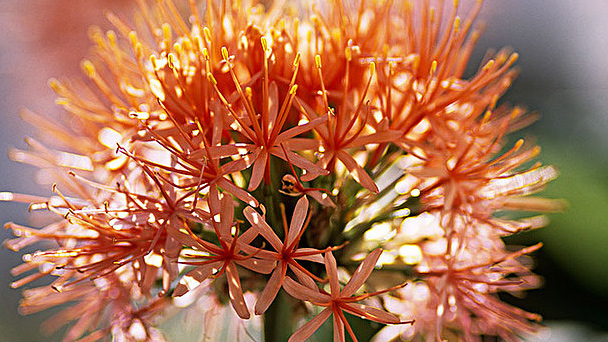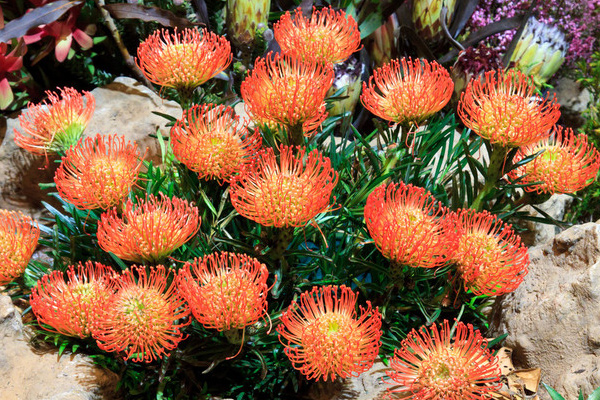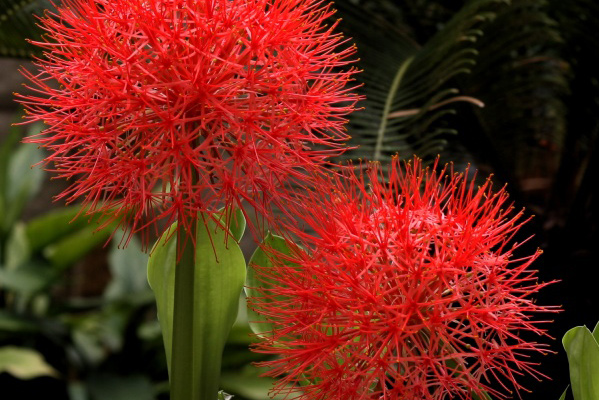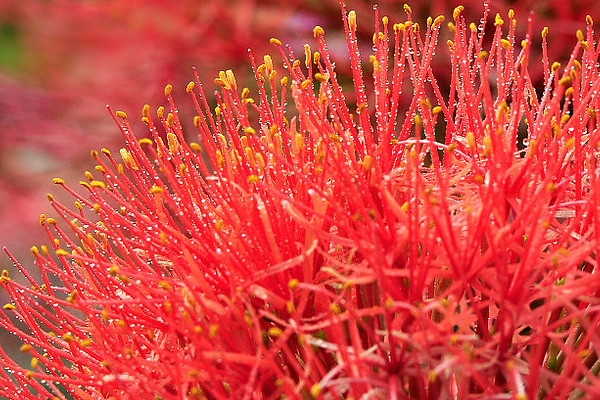Blood Lily: Grow & Care for Scadoxus Multiflorus
Written by Iris
Sep 14 2021

The growth habit of Blood Lily (Scadoxus Multiflorus) is similar to that of the other side flowers of the same family. Blood Lily (Scadoxus Multiflorus) flower shape is like a ball, and its flower color is like blood. So it is called Blood lily. It is native to Africa and is relatively rare.
Here are the steps:
In terms of the ideal location around the house, as long as the desired location is above 15ºC (59ºF) and is at least four metres from an operating heat source, it'll be accepted. Do not situate it in a dark location metres away from a light source, as this will only increase the chance of over-watering. We'd recommend a north, east or west-facing windowsill, or within two metres of a south-facing window.
When the plant is actively growing, water consistently to keep the soil slightly moist. However, as the plant begins to go dormant, stop regular watering and allow the plant to die off. Water only to prevent the soil and dormant plant from drying out completely. Increase watering when the plant begins to grow again.
Dormancy Period - Feeding isn't necessary from spring onwards, as your plant should be entering a period of rest. When the autumn arrives, this is the perfect time to increase fertilisation for fuelling the energy used for developing new leaves

How to Grow Blood Lily (Scadoxus Multiflorus)Blood Lily Propagation with SeedsBlood Lily Propagation with BulbsHow to Care for Blood Lily (Scadoxus Multiflorus)LightSoilWaterTemperature and HumidityFertilizerPruningPests and DiseasesBlood Lily (Scadoxus Multiflorus) FAQWhat the red pods or fruit are on my blood lily?Is blood lily toxic?
How to Grow Blood Lily (Scadoxus Multiflorus)
Blood Lily Propagation with Seeds
As with other bulbous plants, Blood Lily can be propagated from seed. The fleshy seeds should be sown soon after ripening as they are only viable for a short period- Sow into a deep seed tray filled with well-drained, sandy compost
- Press seeds lightly into the surface of the compost so the top of the seed is showing
- Maintain at 16-18ºC (61-64ºF)
- Water well initially and then only when the leaves appear. Take care not to over water and make the soil soggy
- Young plants can be left in the seed trays for several years before potting up
Blood Lily Propagation with Bulbs
This South African relative of the Amaryllis also grows from bulbs. blood lily is warm-natured like its cousin and will begin to grow as soon as it is potted. You can start it any time of year, as long as you can provide enough sunlight for it.Here are the steps:
- Pot bulb in a 6- to 8-inch (15-20 cm) pot, using all-purpose houseplant potting mix. Leave the tip of the bulb above the soil line.
- Water just enough to lightly moisten the potting medium. Once you see new growth, increase watering to keep the medium evenly moist.
- Feed every 2 weeks (see "Fertilizer" below).
- Be patient - it takes several months from the time the bulb is planted until you see Blood Lily bloom. It is so worth the wait.

How to Care for Blood Lily (Scadoxus Multiflorus)
Light
A location with either a splash of morning or evening sun is the ideal setting for this species, as too dark areas will heighten the chance of root rot and a lack of flowers in the autumn. Although direct sunlight is beneficial for Paintbrush Lilies, avoid scorching the leaves with too intense rays as this will quickly lead to a murky lime appearance.In terms of the ideal location around the house, as long as the desired location is above 15ºC (59ºF) and is at least four metres from an operating heat source, it'll be accepted. Do not situate it in a dark location metres away from a light source, as this will only increase the chance of over-watering. We'd recommend a north, east or west-facing windowsill, or within two metres of a south-facing window.
Soil
Loamy or sandy soil that is rich in nutrients is ideal for the blood lily. These soil types offer good drainage, which is important since these plants fare poorly in soggy soil. If potted in containers, mix rich potting soil with sand. This mixture will allow the soil to stay moist while offering excellent drainage, which is important for a healthy plant.Water
Blood lily plants have moderate watering needs; avoid overwatering. Your watering schedule for a blood lily will vary based upon the plant's growing stage.When the plant is actively growing, water consistently to keep the soil slightly moist. However, as the plant begins to go dormant, stop regular watering and allow the plant to die off. Water only to prevent the soil and dormant plant from drying out completely. Increase watering when the plant begins to grow again.
Temperature and Humidity
Average room temperatures 65-80°F/18-27°C suit this South African native. It will tolerate a minimum of 50°F/10°C. Keep your plant away from drafts from heating vents and cold blasts from doors and windows. This tropical native will tolerate average room humidity (around 40% relative humidity). Air can get extremely dry indoors and need a boost. The most efficient way to raise the humidity around your tropical plants is with a cool-mist room humidifier.Fertilizer
Active Growth - From late summer to early spring, fertilise your specimen every three or four waters, using a 'Houseplant' labelled feed. If you're interested in achieving blooms, use a 'Tomato' labelled product to stimulate a flower spike from the heightened levels of potassium.Dormancy Period - Feeding isn't necessary from spring onwards, as your plant should be entering a period of rest. When the autumn arrives, this is the perfect time to increase fertilisation for fuelling the energy used for developing new leaves
Pruning
Pruning and training is generally not required, just remove the spent flowers unless you are collecting the seed.Pests and Diseases
Keep an eye out for spider mites, thrips, aphids, mealybugs and snails if kept outdoors over the summer. Common diseases with Paintbrush Lilies root rot, powdery mildew, leaf-spot disease and botrytis petal blight. Most diseases are caused by excess moisture in the soil or on the flowers or foliage; maintain dry leaves and always avoid water-logging for best results.
Blood Lily (Scadoxus Multiflorus) FAQ
What the red pods or fruit are on my blood lily?
These are the seedpods of the lily, whose Latin name is scadoxus multiflorus or Haemanthus multiflorus. When the red pods begin to crinkle they are ready to harvest. Fill a pot with damp potting soil and scatter the seeds on the surface. Press them lightly to have good contact with the soil but do not bury them. When they germinate, carefully lift each seed and its small white root with the tip of a knife and transplant into individual pots.Is blood lily toxic?
This plant is classified as slightly poisonous. If parts of the plants are eaten, vomiting, nausea and a loss of appetite could occur. Consumption of large quantities must be dealt with quickly; acquire medical assistance for further information.
Latest Updated
- Benefits of Bugleweed - 7 Science-backed Health Benefits
- Bugleweed Dangers & Side Effects - Is It Poisonous?
- How to Plant Evergreen Trees - What You Should Know
- When to Plant Evergreens - Grow Guide for Evergreen Trees
- 12 Wonderful Evergreen Shrubs for Your Garden
- 12 Popular Evergreen Plants with Pictures for Beginners
- When And How To Prune A Lilac Bush Like a Pro
- How to Grow & Care for Lilac Vine (Hardenbergia Violacea)
- Japanese Lilac Tree (Syringa Reticulata) Care & Propagation Guide
- Shumard Oak Pros and Cons - What to Know
Popular Articles
- Winter maintenance of Antirrhinum Majus
- How to Grow Terminalia Mantaly Tree
- How to Grow and Care for Crossostephium Chinense
- How to grow Antirrhinum Majus in spring
- Peristeria Elata (Dove Orchid) Profile: Info & Care Guide
- Underwatered Snake Plant (Sansevieria Trifasciata) - Signs And How To Fix
- How to Care for Brazilian Jasmine Plant (Mandevilla Sanderi)
- How to Grow & Care for Graptopetalum Purple Delight in Summer
- Rosa Chinensis (China Rose): Plant Growing & Care Tips
- How to Care for Baby Sun Rose (Aptenia Cordifolia)